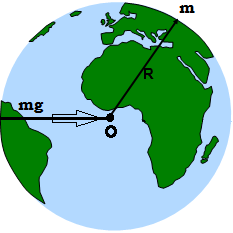The asteroid Ceres has a mass of #7*10^20# #kg# and a radius of #500# #km#. What is #g# on the surface of Ceres? How much would a #99# #kg# astronaut weigh on Ceres?
1 Answer
and the astronaut would weigh
Explanation:
To solve this question, we'll first need to understand how we can arrive at the value of
From Newton's Universal Law of Gravitation, we have:

Where,
and
(For a sphere, the centre of mass lies at its geometrical centre.)
But from Newton's Second Law, we have:
Substituting this in the first equation, we have
For a system consisting of an object on a planet or natural satellite,
and
Since the radius of a planet is so huge, we can usually neglect small distances from it. The image looks more like this now:

Alright, so we have reached on our final equation:
It's interesting to notice that the value of
Now, substituting the values we have for Ceres, we get:
or,
Now for the second part, we know that the weight of an object
Substituting the values we have,
(You can compare this with
In case you want to know what a weighing scale from Earth would show in case the astronaut stepped on it on Ceres, you can divide his weight by
which is
That's just what a weighing scale would show as we'd feel lighter on Ceres. The actual mass of the astronaut has not decreased!
